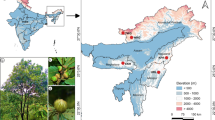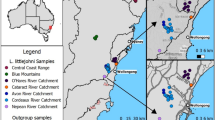Abstract
Allozyme variation was examined in 1571 white-tailed deer (Odocoileus virginianus) from 29 localities in Tennessee by starch gel electrophoresis. For 11 polymorphic loci, sex-related, age-related and temporal differences were minimal. However, significant spatial hererogeneity was evident in genotypes (contingency table results), allele frequencies (F ST=0.057) and heterozygosity. Heterozygosity ranged from 16.9% to 26.8% with a mean of 22.9%. The spatial pattern of allele frequencies determined from Rogers' coefficients of genetic similarity indicated associations based on geographic proximity and stocking history. In hierarchial analyses, physiographic regions accounted for more of the total gene diversity than herd origin groups (populations of similar origin) but less than individual populations. For five loci, physiographic regions accounted for more of the gene diversity than populations, suggesting a selection role in the observed genetic variability. Bivariate and canonical correlation analyses revealed significant associations between environmental and genetic variables. Temperature variables and allele frequencies for three loci (alcohol dehydrogenase, alpha-glycerophosphate dehydrogenase, sorbitol dehydrogenase) had the prominent roles in the multivariate association between environmental and genetic variables. Herd origin, gene flow and selection appear to be involved in the gene diversity in deer from Tennesee.
Similar content being viewed by others
References
Alahiotis, S. N., 1982. Adaptation of Drosophila enzymes to temperature. IV. Natural selection at the alcohol-dehydrogenase locus. Genetica 59: 81–87.
Ayala, F. J., 1976. Molecular evolution. Sinauer, Sunderland, Massachusetts.
Baccus, R., Ryman, N., Smith, M. H., Reuterwall, C. & Cameron, D., 1983. Genetic variability and differentiation of large grazing mammals. J. Mammal. 64: 109–120.
Baccus, R., Hillestad, H. O., Johns, P. E., Manlove, M. N., Marchinton, R. L. & Smith, M. H., 1977. Prenatal selection in white-tailed deer. Proc. Southeast. Assoc. Fish Wildl. Agencies 31: 173–179.
Blackard, J. J., 1971. Restoration of the white-tailed deer in the southeastern United States. M.S. Thesis, Louislana State Univ., Baton Rouge.
Bryant, E. H., 1974. On the adaptive significance of enzyme polymorphisms in relation to environmental variability. Am. Nat. 108: 1–19.
Charlesworth, B. & Giesel, J. T., 1972. Selection in populations with overlapping generations. II. Relations between gene frequency and demographic variables. Am. Nat. 106: 388–401.
Chesser, R. K., 1980. Computer systems and programming for the analysis of population genetics data. Univ. Stockholm Spec. Publ., Rep. 3.
Chesser, R. K., 1983. Genetic variability within and among populations of the black-tailed prairie dog. Evolution 37: 320–331.
Chesser, R. K., Reuterwall, C. & Ryman, N., 1982a. Genetic differentiation of Scandinavian moose Alces alces populations over short geographical distances. Oikos 39: 125–130.
Chesser, R. K., Smith, M. H., Johns, P. E., Manlove, M. N., Straney, D. O. & Baccus, R., 1982b. Spatial, temporal, and age-dependent heterozygosity of beta-hemoglobin in white-tailed deer. J. Wildl. Mgmt. 46: 983–990.
Christiansen, F. B., 1977. Population genetics of Zoarces viviparus (L.): a review. In: Measuring selection in natural populations (F. B. Christiansen & T. M. Fenchel, eds): pp. 21–47. Lecture Notes in Biomathematics, Vol. 19, Springer-Verlag (Berlin).
DillonJr., R. T., 1984. Geographic distance, environmental difference, and divergence between isolated populations. Syst. Zool. 33: 69–82.
Erickson, L. M., 1979. Genetics of white-tailed deer of south Texas. M.S. Thesis, Texas Tech Univ., Lubbock.
Gaines, M. S. & Whittam, T. S., 1980. Genetic changes in fluctuating vole populations: selective vs. nonselective forces. Genetics 96: 767–778.
Gaines, M. S., McClenaghanJr., L. R. & Rose, R. K., 1978. Temporal patterns of allozymic variation in fluctuating populations of Microtus ochrogaster. Evolution 32: 723–739.
Gyllensten, U., 1985. Temporal allozyme frequency changes in density fluctuating populations of willow grouse (Lagopus lagopus L.). Evolution 39: 115–121.
Harris, H. & Hopkinson, D. A., 1976. Handbook of enzyme electrophoresis in human genetics. North-Holland Publ. Co. Amsterdam.
Hartl, D. L., 1980. Principles of population genetics. Sinauer, Sunderland, Massachussetts.
Hedrick, P. W., Ginevan, M. E. & Ewing, E. P., 1976. Genetic polymorphism in heterogeneous environments. Ann. Rev. Ecol. Syst. 7: 1–32.
Henry, V. G., Farrar, J. W. & Murrey, J. D., 1974. Deor restoration in Tennessee: its history and present status. Unpubl. report, Tennessee Wildl. Resources Agency.
Hillestad, H. O., 1984. Stocking and genetic variability of white-tailed deer in the southeastern United States. Ph.D. Dissertation. Univ. Georgia, Athens.
Hines, S. A., Philipp, D. P., Childers, W. F. & Whitt, G. S., 1983. Thermal kinetic differences between allelic isozymes of malate dehydrogenase (Mdh-B locus) of largemouth bass, Micropterus salmoides. Biochem. Genet. 21: 1143–1151.
Kennedy, P. K., 1985. Genetic variability in white-tailed deer (Odocoileus virginianus) and its relationship to environmental parameters and herd origin. Ph.D. Dissertation, Memphis State Univ., Memphis, Tennessee.
Levene, H., 1949. On a matching problem arising in genetics. Ann. math. Statist. 20: 91–94.
Li, C. C. & Horvitz, D. G., 1953. Some methods of estimating the inbreeding coefficient. Am. J. hum. Genet. 5: 107–117.
Manlove, M. N., 1979. Genetic similarity among contiguous and isolated populations of white-tailed deer in Michigan. M.S. Thesis, Michigan State Univ., East Lansing.
Manlove, M. N., Avise, J. C., Hillestad, H. O., Ramsey, P. R., Smith, M. H. & Strancy, D. O., 1975. Starch gel electrophoresis for the study of population genetics in white-tailed deer. Proc. Southeast. Assoc. Game Fish Comm. 29: 392–403.
Manlove, M. N., Smith, M. H., Hillestad, H. O., Fuller, S. E., Johns, P. E. & Straney, D. O., 1976. Genetic subdivision in a herd of white-tailed deer as demonstrated by spatial shifts in gene frequencies. Proc. Southeast. Assoc. Game Fish Comm. 30: 487–492.
McClenaghanJr., L. R., Smith, M. H. & Smith, M. W., 1985. Biochemical genetics of mosquitofish. IV. Changes of allele frequencies through time and space. Evolution 39: 451–460.
Miller, R. A., 1974. The geologic history of Tennessee. Bull. 74, State Tennessee Dept. Conservation Div. Geology, Nashville.
Miller, W. J., Haugen, A. O. & Roslien, D. J., 1965. Natural variation in the blood proteins of white-tailed deer. J. Wildl. Mgmt. 29: 717–723.
Nei, M., 1972. Genetic distance between populations. Am. Nat. 106: 283–292.
Nei, M., 1973. Analysis of gene diversity in subdivided populations. Proc. natn. Acad. Sci. U.S.A. 70: 3321–3323.
Nei, M., 1977. F-statistics and analysis of gene diversity in subdivided populations. Ann. hum. Genet. 41: 225–233.
Nevo, E., 1978. Genetic variation in natural populations: patterns and theory. Theor. Popul. Biol. 13: 121–177.
Nichols, E. A., Chapman, V. M. & Ruddle, F. H., 1973. Polymorphism and linkage for mannosephosphate isomerase in Mus musculus. Biochem. Genet. 8: 47–53.
Nie, N. H., Hull, C. H., Jenkins, J. G., Steinbrenner, K. & Bent, D. H., 1975. SPSS, Statistical package for the social sciences. McGraw-Hill Book Co., New York.
Patton, J. L. & Feder, J. H., 1981. Microspatial genetic heterogeneity in pocket gophers: nonrandom breeding and drift. Evolution 35: 912–920.
Place, A. R. & Powers, D. A., 1978. Genetic bases for protein polymorphism in Fundulus heteroclitus (L.). I. Lactate dehydrogenase (Ldh-B), malate dehydrogenase (Mdh-A), glucosephosphate isomerase (Gpi-B), and phosphoglucomutase (Pgm-A), Biochem. Genet. 16: 576–591.
Price, P. K., Cartwright, M. & Rogers, M. J., 1979. Genic variation in white-tailed deer from Arkansas. Proc. Arkansas Acad. Sci. 33: 64–66.
Ramsey, P. R., Avise, J. C., Smith, M. H. & Urbston, D. F., 1979. Biochemical variation and genetic heterogeneity in South Carolina deer populations. J. Wildl. Mgmt. 43: 136–142.
Rogers, J. C., 1972. Measures of genetic similarity and genetic distance. Stud. Genet. VII. Univ. Texas Publs 7213: 145–153.
Rohif, R. J., Kishpaugh, J. & Kirk, K., 1982. Numerical taxonomy system of multivariate statistical programs. State Univ. New York, Stony Brook.
Ryman, N., Baccus, R., Reuterwall, C. & Smith, M. H., 1981. Effective population size, generation interval, and potential loss of genetic variability in game species under different hunting regimes. Oikos 36: 257–266.
Schaffer, H. E. & Johnson, F. M., 1974. Isozyme allelic frequencies related to selection and gene-flow hypotheses. Genetics 77: 163–168.
Schultz, V., 1955. Status of the white-tailed deer in Tennessee. J. Tennessee Acad. Sci. 30: 66–75.
Selander, R. K., Smith, M. H., Yang, S. Y., Johnson, W. E. & Gentry, J. B., 1971. Biochemical polymorphism and systematics in the genus Peromyscus. I. Variation in the old-field mouse (Peromyscus polionotus). Stud. Genet. VI. Univ. Texas Publs 7103: 49–90.
Sheffield, S. R., MorganII, R. P., Feldhamer, G. A. & Harman, D. M., 1985. Genetic variation in white-tailed deer (Odocoileus virginianus) populations in western Maryland. J. Mammal. 66: 243–255.
Smith, M. H., Manlove, M. N. & Joule, J., 1978. Spatial and temporal dynamics of the genetic organization of small mammal populations. In: Populations of small mammals under natural conditions (D. P. Snyder, ed): pp. 99–113. Special Publs Series, Vol. 5. Pymatuning Lab. Ecol., Univ. Pittsburg, Pittsburg, Pennsylvania.
Smith, M. H., Baccus, R., Hillestad, H. O. & Manlove, M. N., 1984. Population genetics. In: White-tailed deer: ecology and management (L. K. Halls, ed): pp. 119–128. Stackpole Books, Harrisburg, Pennsylvania.
Smith, M. H., Chesser, R. K., Cothran, E. G. & Johns, P. E., 1982. Genetic variability and antler growth in a natural population of white-tailed deer. In: Antler development in Cervidae (R. D. Brown, ed): pp. 365–387. Caesar Kleberg Wildl. Res. Institute, Kingsville, Texas.
Tabachnick, B. G. & Fidell, L. S., 1983. Using multivariate statistics. Harper and Row, New York.
Taylor, C. E. & Mitton, J. B., 1974. Multivariate analysis of genetic variation. Genetics 76: 575–585.
Tennessee Wildlife Rescources Agency, 1984. Big game harvest data and range surveys 1983–84. Tennessee Wildl. Res. Agency Technical Rep., 84-1, PCAN 0064/350.
Thornthwaite Associates, 1964. Average climatic water balance data of the continents. Lab. Climatol., Publs Climatol. 17: 419–615.
Tinkle, D. W. & Selander, R. K., 1973. Age dependent allozymic variation in a natural population of lizards. Biochem. Genet. 8: 231–237.
Tomaszewski, E. K., Schaffer, H. E. & Johnson, F. M., 1973. Isozyme genotype-environment associations in natural populations of the harvester ant, Pogonomyrmex badius. Genetics 75: 405–421.
United States Department of Commerce, 1973. Climatography of the United States (by state). Monthly normals of temperature, precipitation, and heating and cooling degree days 1941–70.
Workman, P. L. & Niswander, J. D., 1970. Population studies on southwestern Indian tribes. II. Local genetic differentiation in the Papago. Am. J. hum. Genet. 22: 24–49.
Wright, S., 1965. The interpretation of population structure by F-statistics with special regard to systems of mating. Evolution 9: 395–420.
Wright, S., 1969. Evolution and genetics of populations. Vol. 2, The theory of gene frequencies. Univ. Chicago Press, Chicago.
Author information
Authors and Affiliations
Rights and permissions
About this article
Cite this article
Kennedy, P.K., Kennedy, M.L. & Beck, M.L. Genetic variability in white-tailed deer (Odocoileus virginianus) and its relationship to environmental parameters and herd origin (Cervidae). Genetica 74, 189–201 (1987). https://doi.org/10.1007/BF00056114
Received:
Accepted:
Issue Date:
DOI: https://doi.org/10.1007/BF00056114




